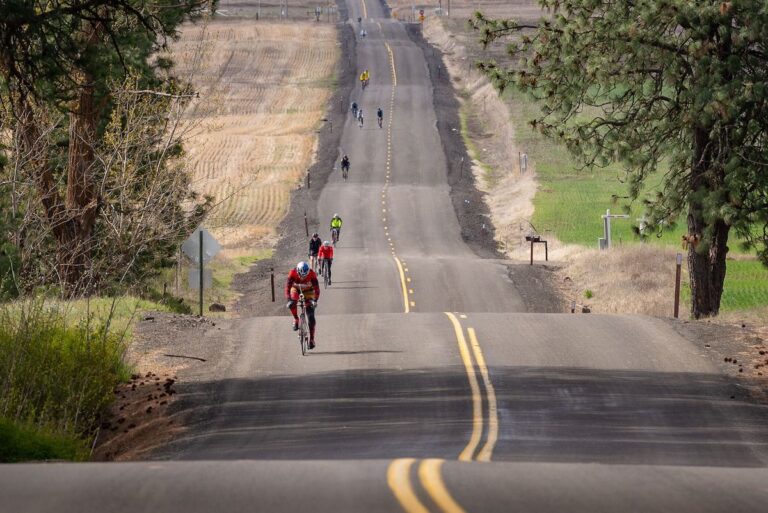Springsteen got it right when he sang, “Tramps like us, baby, we were born to run.” At the most basic level, young children need to run. If you doubt this, watch a four or five year old play with a hyper dog in a wide, open space. Their delight is instinctual and completely undeniable. Their zigzag motion and the aerobic activity are liberating and fun. At the heart of it all, more kids (and more people) should be that active.
Based on Spokane’s unique running heritage, the strength of the local, nationally-ranked high school cross country teams, and the cult-like power of Bloomsday, one would think that elementary school running programs would always be secure. But that’s not the case since many physical education and after-school sports have been cut and/or eliminated altogether. Back in 2003-04, Spokane District 81 quit providing transportation for five sports—cross country, basketball, volleyball, softball and track and field. Nobody welcomes the fiscal crisis this state is facing, but with such a huge rise in childhood obesity and juvenile delinquency it’s a fair question to ask: why would anyone even consider shutting the door on the school running programs? While running isn’t as popular or as publicized as basketball, football or soccer for elementary age kids, it’s impossible to deny that it’s the foundation of those other three sports. Although not every kid wants to become a distance runner, even minimal amounts of running provide huge health benefits as well as improve their stamina for the other games.
Mike Bresson laces his running shoes with more care than most power executives lace their ties. Brimming with energy, he’s a talented lawyer, an accomplished runner, and coming this March he will be a new dad. He is also the founder of Active4Youth, the local non-profit that works to provide afterschool sports programs for Spokane-area children. “It’s tough to see after school programs cut because … well, no one likes to see them cut but at least now there’s a chance to do something about it,” says Bresson.
I contacted Bresson. in early February and made arrangements to go for a run with him. Well before sunrise, we had the Centennial Trail to ourselves and, for me at least, it was one of the best workouts I’d had all month. Built like a runner, Bresson’s lean and light and full of power. More than one person remarked that if he’s passionate about something, then he’s really passionate about it. He asks questions quickly, and smiles often.
Bresson came to running slightly by accident after years of playing soccer. He played at California Lutheran University, and then started running to up his fitness ante. Following Gonzaga Law, he consumed a steady diet of marathons and then ultra marathons. Eventually, a good friend pulled him aside and suggested he stop running slow, mind-numbing long routes, and inject some competitive speed into his exercise routine. His friend suggested Bresson start training to compete, since you’re only young once. So Bresson put his heart into it, and started to train emphatically for the 26.2 mile race. Along the way he has struggled with injuries from time to time. To date, he has clocked an impressive 2:22 marathon. Better still, he is actively training to break 2:20. However, he readily confesses the arrival of his first baby might make a few changes in his training program, so he isn’t quite sure which marathon he will specifically target his 2010 training for.
Bresson previously served with the local chapter of the Susan G. Komen Race For The Cure. Working with that cause and seeing how the community reacted to that race really encouraged him, and it really showed him what Spokane could do. He also learned all the inside workings of a charity, and how to write grants, and how to connect with the swell of runners and active parents throughout the entire city. All in all, that period underscored his ideas for getting A4Y off the ground, and really propelled him to get after school running back into the community’s field of vision.
Active4Youth aims to make local children more active. A4Y exists to heighten the community’s awareness of the drastic increase in childhood obesity and the problems it can cause in children’s health, as well as increase the awareness of the juvenile delinquency problems that occur during unsupervised after-school hours. While it’s easy to posture and point at others, laying the blame on poor food choices and time-wasting video games, A4Y presents a viable option to change attitudes and behaviors in Spokane right here and right now.
Arguably the biggest and most measurable gains came from the elementary afterschool cross country program. In association with Spokane Public Schools and many generous sponsors, Active4Youth revived the cross country program and included all 34 of the District’s elementary schools. The schools averaged almost 90 participants, with some schools reporting 120-150 students.
“Running is a great equalizer. Both girls and boys responded well, and we even bolstered the PE programs at most of the schools,” says Bresson. Whereas affluent neighborhoods are more likely to afford helmets and pads, or summer basketball camps, or weekend after weekend of Little League games, the after-school running with A4Y just required decent shoes, a fair commitment and a strong will.
Active4Youth Cross Country operates easy and simple. The schools are separated into zones, roughly 4 or 5 schools in a ten mile radius, which compete against each other in two regional zone meets. Students race against others in their same grade. Those students meeting a certain time threshold or placing in their respective grade race will qualify to race in the Active4Youth All-City Cross Country Meet. Last year nearly 500 boys and girls qualified for the All-City race, and the enthusiasm for the event carried over enormously.
Ginette Kerkering has two kids in the A4Y program at Wilson Elementary on the South Hill. Although the school maintained a running program after the District’s major cuts, the involvement of Active4Youth made a huge difference. At Wilson, it added another level to the already existing running club. With the addition of interschool meets and citywide involvement, the running at Wilson really flourished. With more kids involved, more teachers and more families had to become involved. The viral effect of the program worked in favor of the kids.
Regarding the A4Y All-City Meet, Kerkering says, “I think that the greatest thing that I saw at the Meet was the way everyone was so excited for everyone else. The kids did a great job cheering each other on and appreciated improvements in one another’s races. My daughter says that she just likes the way she feels when she runs and when she runs hard, she runs with true joy on her face. On a more academic note, Wilson generally met in the morning to run. My daughter felt like it was easier to concentrate in the mornings on the days that she ran. My son just felt great being out there with the big kids who were very kind to the few kindergartners out there.”
Finch Elementary on the northwest side of town boasted one of the largest groups. Their participation easily crested the 150. “It sure is a true testament to whether this program is a need in Spokane,” says Fitness and Health teacher and coach, Dan Farely.
A4Y also dovetails nicely with the Fit For Bloomsday…Fit For Life mission. Since 1987 the Lilac Bloomsday Association has had a major impact on Spokane’s youngsters through its “Fit For Bloomsday” program, and they viewed A4Y as a natural extension. Operating alongside the Fit For Bloomsday program, during Bloomsday weekend, there’s also a Marmot March for children in second grade or younger. It’s a 1.2-mile non-competitive walk/jog/run for children. This will be the fifth year this event has been held, and they anticipate lots of local Sports Team Mascots to cheer the kids and promote walking and jogging as enjoyable activities.
Don Kardong says, “Active4Youth has managed to restart a program that has a profound impact on kids at a time when the need for fitness activities for young kids is enormous. The Bloomsday Association was really pleased to support restarting of the elementary cross country program. Encouraging fitness in the community is part of our mission, so this was right up our alley. We hope other organizations and individuals will join us in supporting Active4Youth.”
Eugene Buchanan, author of Outdoor Parents, Outdoor Kids, writes, “If you have healthy, active kids, you don’t really need to encourage them to run. It’s not like riding a bike. They figure it out themselves pretty easily … like the first time they hurt their older brother and have to run away. I don’t think there’s such a thing as a how-to-video on teaching your child to run, and I’ve never witnessed a parent saying, ‘Okay sweetie, just move your legs back and forth real fast … now swing your arms a little. No, the arm opposite from your leg.’ Running is programmed in as a survival skill, and comes in handy throughout their lives, whether it’s girls running away from boys, boys avoiding cooties, and kids of all ilk running away from their parents at suppertime.”
Despite a perception of being expendable or even frivolous, running programs provide an important mechanism to reach large numbers of children and engage them in healthy and positive activities during non-school hours. More children and youth chose to take part in sports programs than in any other afterschool activity. An estimated 38 million young people participate in youth sports programs in the United States. Ultimately, these sports programs can help address the growing problems of inactivity and obesity among Spokane area children and youth.
Today, there are nearly twice as many overweight children and almost three times as many overweight adolescents as there were in 1980. According to the International Obesity Task Force, 13% of all children in the United States are overweight or obese. Drilling into the statistics even further, a U.S. National Health and Nutrition Examination Survey estimates that 16% of children ages 6-17 are overweight, and more than 10% of preschool children ages 2-5 are overweight (up from 7% in 1994). More disturbing, a Center for Disease Control report says that the percentage of overweight children ages 6-11 has doubled since the late 1980’s, and the percentage of overweight adolescents has risen nearly three hundred percent.
Even more alarming, juvenile crime triples when the school bell rings at the end of the day. Studies show that adolescents that are unsupervised for 11 or more hours per week experience twice the risk of substance abuse as those who are under some form of adult supervision. However, children with an afterschool program are two times less likely to use drugs, and one-third less likely to become teen parents. Sports also help children develop better conflict resolution skills. Afterschool running programs keep our children safe and provide them with much needed, supervised, structured activity that will deter delinquency and encourage healthy lifestyle choices.
Even though the numbers are discouraging, all the evidence points toward starting kids running early. A fitness survey of 6,000 adults found that 25% of those who were considered active at ages 14-19 were also active adults, while just 2% of those who were inactive at ages 14-19 were said to be active adults.
Bresson is far too kind to admit it, but I was definitely holding him back. We crossed the Spokane River at the Green Street Bridge and let the conversation wander from travels, to kids, to siblings, to local high school cross country coaches, and even the Flying Irish at O’Doherty’s Irish Grille. Bresson also boasted about his wife, Heidi, and some of her running achievements. The conversation rolled out seamlessly, and it always returned to the strength of the local running community and the brilliant opportunities for running if kids were only given the chance. One of us noted the 2010 USA Cross Country Championships were being held right here in Spokane, and we both lamented that the Coeur d’Alene Marathon and the Windermere Marathon—both have very good racecourses—were held so close together. It didn’t seem fair to make runners choose between such good local marathons in the spring.
By the time Mike and I finished our run together, the Centennial Trail started to come to life. We exchanged friendly waves or nods with other morning runners that passed by. Most of the streetlights had turned off. The sweat and drizzle thoroughly drenched us, but neither minded. Although I felt wiped out, Mike looked ready to race that loop at least six more times.
Back where we started, Mike had agreed to tell me which marathon he selected for his PR when he knew.
That’s when I said, “Tell me again, when is your wife due?”
“Around the middle of March,” he replied.
“Wow, so you might be a Dad by the time people are reading this,” I said.
He nodded and smiled.
Years before his own child was imagined, Bresson led the push to reinstate the district-wide elementary cross country program that was cancelled back in 2004 so Spokane’s youth might enjoy the option and the challenge of running. Even as Active4Youth enters its third year, Bresson continues to redefine going the extra mile, and the entire community benefits from it.
That must be why Peter Ellis, Coordinator of Fitness & Health at Spokane Public Schools, stated, “From the very first time we met years ago, I’ve been impressed with Mike’s energy and enthusiasm. It has taken a number of years to get to this point, but his vision for the program from the beginning stayed focused because the intent was right. His positive outlook affects everyone and everything he touches.”
If you would like to learn more, volunteer, or make a donation, please visit www.active4youth.org.












